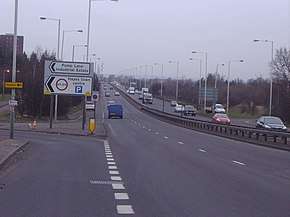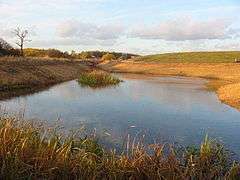A312 road
The A312 is an A road in England, running across west London from Hampton to Harrow. Its status varies from a local urban street to a major dual carriageway. Part the road has been diverted to make way for Heathrow Airport, while another stretch was originally planned to be Ringway 3, one of four major ring motorways around London.
| |
|---|---|
 View of the A312 road ('The Parkway') in Hayes | |
| Route information | |
| Length | 13.5 mi (21.7 km) |
| Major junctions | |
| North end | Harrow |
| South end | Hampton |
| Location | |
| Primary destinations | Heathrow Airport |
| Road network | |
Route
The road is part primary, part non-primary, which reflects its status as a mix of local and regionally important traffic. The primary section of the road, under the name The Parkway (and part of it as Hayes Bypass), is a 5-mile dual carriageway trunk road with speed limits of 40 to 50 mph, running north–south from Northolt's Target Roundabout to the A30 interchange in Hatton.
The non-primary section is mostly a single carriageway and consist of urban roads, particularly the northern part, where it serves as the main road of Northolt and South Harrow. The southern end goes through more residential areas and ends at the foot of Bushy Park. The A308 to Hampton Court Palace and Sunbury-on-Thames is a short distance to the south.
History
Originally, the middle section from Hatton to Hayes ran via Harlington.[1] This road from Hatton to Harlington (then a country road) was demolished in the 1940s during the construction of Heathrow Airport - the northern half of the road in Harlington remains today as the A437, High Street. The A312 itself was rerouted from Hatton via a new road through Cranford to Hayes which opened c. 1959, again via today's A437 (North Hyde Road).[2]
Later, a new road called The Causeway was built, cutting between the two balancing reservoirs of Heathrow's water pollution control. The A312 no longer went via the centre of Hatton (by Hatton Cross tube station) and joining the A30, instead going straight from Faggs Road via The Causeway to The Parkway.
London Ringways
The section of the road between Heathrow and Hayes was originally planned to be part of the Ringway 3 scheme, one of four concentric ring roads around London as part of the London Ringways project. In 1969, the Greater London Council widened the A312 north of the A30 near Heathrow to dual carriageway. Named The Parkway, it was intended to eventually become Ringway 3. [3] In November 1975, the Transport Minister John Gilbert announced that the sections of Ringway 3 in south and west London, including the Parkway, were cancelled. They would be replaced by the M25, running further away from London.[4]
Hayes Bypass
The Hayes Bypass section of The Parkway was opened, after long delay, in September 1992,[5] cutting through Bulls Bridge, Pump Lane Industrial Estate and Yeading. The A312 thus also no longer went through Yeading Lane, the main road of Yeading, and that was afterwards changed to a local road. The bypass also led to the creation of White Hart Roundabout, named after a pub nearby.
At the time, the town centre of Hayes and Old Southall were heavily congested beyond its supply.[6] This was partly because there was no direct link between the A40 Western Avenue at Northolt and the M4 motorway (which leads to Heathrow). Although supported by the local councils (Hounslow, Hillingdon, Ealing) and the Greater London Council,[7] the Hayes Bypass was long delayed, and construction would not start until the late 1980s.[8]
The new trunk road provided relief to Hayes town centre and eventually led to it to be pedestrianised.[9]
Gallery
 A312 Lower Road, looking east towards West Street and Harrow on the Hill
A312 Lower Road, looking east towards West Street and Harrow on the Hill A312 Northolt Road in South Harrow
A312 Northolt Road in South Harrow Minet Country Park just off The Parkway in Hayes
Minet Country Park just off The Parkway in Hayes The Parkway bridge running over the Grand Union Canal near Hayes
The Parkway bridge running over the Grand Union Canal near Hayes_just_prior_to_opening._Hayes%2C_Middlesex_-_geograph.org.uk_-_40562.jpg) The Hayes Bypass shortly before its opening in 1992, when the completed road was in use for the Hillingdon Cycle Circuit
The Hayes Bypass shortly before its opening in 1992, when the completed road was in use for the Hillingdon Cycle Circuit The A312 running through Hayes town centre in 1981, before the creation of the bypass to the east
The A312 running through Hayes town centre in 1981, before the creation of the bypass to the east View of The Parkway near Cranford
View of The Parkway near Cranford The A312 Harlington Road East and a walkway running over the Waterloo-Reading rail line near Feltham
The A312 Harlington Road East and a walkway running over the Waterloo-Reading rail line near Feltham The abandoned Grade II-listed Hanworth Park House just off the A312 Uxbridge Road
The abandoned Grade II-listed Hanworth Park House just off the A312 Uxbridge Road The Pantile Bridge crossing the Longford River, across the very southern end of the A312 in Hampton
The Pantile Bridge crossing the Longford River, across the very southern end of the A312 in Hampton
See also
- RAF Northolt
- Northala Fields
- Heston services
- Hanworth Air Park
References
Citations
- Ministry of Transport Road Map Sheet 34 (London) (Map). Ordnance Survey. 1923. Retrieved 18 May 2019.
- "View: Bartholomew's Revised Half-Inch Map, Surrey - Great Britain, Sheet 9 (England &a... - Bartholomew's Revised Half-Inch Map, Great Britain, 1940-47". maps.nls.uk.
- Asher 2018, p. 114.
- Asher 2018, p. 116.
- "House of Commons Hansard Debates for 15 Dec 1992". publications.parliament.uk.
- "RINGWAY 3(HAYES) (Hansard, 1 May 1974)". api.parliament.uk.
- "HAYES BYPASS (Hansard, 17 January 1980)". api.parliament.uk.
- Travers 2015, p. 181.
- Griffith, Jack (November 26, 2013). "£4.5m vision for the future of Hayes town centre revealed". getwestlondon.
Sources
- Travers, Tony (November 24, 2015). London Boroughs at 50. Biteback Publishing. ISBN 978-1-785-90011-2.CS1 maint: ref=harv (link)
- Asher, Wayne (2018). Rings Around London: Orbital motorways and the battle for homes before roads. Capital History. ISBN 978-1-854-14421-8.CS1 maint: ref=harv (link)
